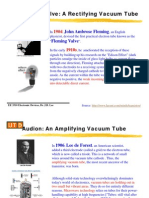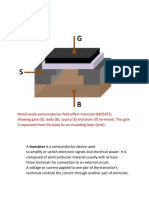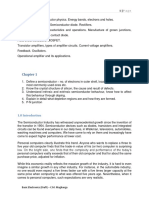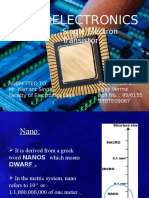Vacuum Channel MOSFET
Vacuum Channel MOSFET
Uploaded by
prakashroutCopyright:
Available Formats
Vacuum Channel MOSFET
Vacuum Channel MOSFET
Uploaded by
prakashroutOriginal Description:
Copyright
Available Formats
Share this document
Did you find this document useful?
Is this content inappropriate?
Copyright:
Available Formats
Vacuum Channel MOSFET
Vacuum Channel MOSFET
Uploaded by
prakashroutCopyright:
Available Formats
6/28/2014 Introducing the Vacuum Transistor: A Device Made of Nothing - IEEE Spectrum
http://spectrum.ieee.org/semiconductors/devices/introducing-the-vacuum-transistor-a-device-made-of-nothing/?utm_source=techalert&utm_medium=email&utm 1/7
IntroducingtheVacuumTransistor:ADeviceMadeofNothing
Thiscuriousmash-upofvacuumtubeandMOSFETcouldonedayreplacetraditional
silicon
ByJin-WooHan&MeyyaMeyyappan
Posted23Jun2014|16:14GMT
Illustration: Chad Hagen
in the midst of the Cold War,
Victor Ivanovich Belenko, a disgruntled Soviet pilot,
veered off course from a training flight over Siberia in
his MiG-25 Foxbat, flew low and fast across the Sea of
Japan, and landed the plane at a civilian airport in
Hokkaido with just 30 seconds of fuel remaining. His
dramatic defection was a boon for U.S. military
analysts, who for the first time had an opportunity to
examine up close this high-speed Soviet fighter, which
they had thought to be one of the worlds most capable
aircraft. What they discovered astonished them.
In September 1976,
For one thing, the airframe was more crudely built
than those of contemporary U.S. fighters, being made
mostly of steel rather than titanium. Whats more, they
found the planes avionics bays to be filled with
equipment based on vacuum tubes rather than
transistors. The obvious conclusion, previous fears
aside, was that even the Soviet Unions most cutting-
edge technology lagged laughably behind the Wests.
After all, in the United States vacuum tubes had given way to smaller and less power-hungry solid-state
devices two decades earlier, not long after William Shockley, John Bardeen, and Walter Brattain cobbled
together
at Bell Laboratories in
1947 . By the mid-197 0s, the only vacuum tubes you could find in Western electronics were hidden away in
certain kinds of specialized equipmentnot counting the ubiquitous picture tubes of television sets. Today
even those are gone, and outside of a few niches, vacuum tubes are an extinct technology. So it might come
as a surprise to learn that some very modest changes to the fabrication techniques now used to build
integrated circuits could yet breathe vacuum electronics back to life.
the first transistor
(http://en.wikipedia.org/wiki/History_of_the_transistor#The_first_transistor)
At the , weve been working for
the past few years to develop vacuum-channel transistors. Our research is still at an early stage, but the
prototypes weve constructed show that this novel device holds extraordinary promise. Vacuum-channel
NASA Ames Research Center (http://www.nasa.gov/centers/ames/home/)
6/28/2014 Introducing the Vacuum Transistor: A Device Made of Nothing - IEEE Spectrum
http://spectrum.ieee.org/semiconductors/devices/introducing-the-vacuum-transistor-a-device-made-of-nothing/?utm_source=techalert&utm_medium=email&utm 2/7
transistors could work 10 times as fast as ordinary silicon transistors and may eventually be able to
operate at terahertz frequencies, which have long been beyond the reach of any solid-state device. And
they are considerably more tolerant of heat and radiation. To understand why, it helps to know a bit about
the construction and functioning of good old-fashioned vacuum tubes.
(/img/07VacuumTriode_tube_1906-
1403113904214.jpg)
Photo: Gregory Maxwell
Vacuum tubes were an outgrowth of
ordinary lightbulbs, a development spurred on by Thomas
Edisons investigations into the ability of heated f ilaments to
emit electrons. This 1906 example, an early Audion tube,
shows the close resemblance to a lightbulb, although the
f ilament in this particular tube is not visible, having long ago
burned out. That f ilament once acted as the cathode f rom
which electrons f lew toward the anode or plate, which is
located in the center of the glass tube. Current f low f rom
cathode to anode could be controlled by varying the voltage
applied to the grid, the zigzag wire seen below the plate.
LightbulbDescendant:
s that amplified
signals in countless radio and television sets during the
first half of the 20th century might seem nothing like
the metal-oxide semiconductor field-effect transistors
(MOSFETs) that regularly dazzle us with their
capabilities in todays digital electronics. But in many
ways, they are quite similar. For one, they both are
three-terminal devices. The voltage applied to one
terminalthe grid for a simple triode vacuum tube and
the gate for a MOSFETcontrols the amount of current
flowing between the other two: from cathode to anode
in a vacuum tube and from source to drain in a
MOSFET. This ability is what allows each of these
devices to function as an amplifier or, if driven hard
enough, as a switch.
The thumb-size vacuum tube
How electric current flows in a vacuum tube is very
different from how it flows in a transistor, though.
Vacuum tubes rely on a process called
: Heating the cathode causes it to
shed electrons into the surrounding vacuum. The current in transistors, on the other hand, comes from the
drift and diffusion of electrons (or of holes, spots where electrons are missing) between the source and
the drain through the solid semiconducting material that separates them.
thermionic
emission
(http://www.eng.fsu.edu/~dommelen/quantum/style_a/cboxte.html)
Why did vacuum tubes give way to solid-state electronics so many decades ago? The advantages of
semiconductors include lower costs, much smaller size, superior lifetimes, efficiency, ruggedness,
reliability, and consistency. Notwithstanding these advantages, when considered purely as a medium for
transporting charge, vacuum wins over semiconductors. Electrons propagate freely through the
nothingness of a vacuum, whereas they suffer from collisions with the atoms in a solid (a process called
crystal-lattice scattering). Whats more, a vacuum isnt prone to the kind of radiation damage that plagues
semiconductors, and it
than solid-state materials.
produces less noise and distortion (/consumer-electronics/audiovideo/the-cool-
sound-of-tubes/3/distortion)
6/28/2014 Introducing the Vacuum Transistor: A Device Made of Nothing - IEEE Spectrum
http://spectrum.ieee.org/semiconductors/devices/introducing-the-vacuum-transistor-a-device-made-of-nothing/?utm_source=techalert&utm_medium=email&utm 3/7
The drawbacks of tubes werent so vexing when you just needed a handful of them to run your radio or
television set. But they proved really troublesome with more complicated circuits. For example, the 1946
, which
used 17 ,468 vacuum tubes, consumed 150 kilowatts of power, weighed more than 27 metric tons, and took
up almost 200 square meters of floor space. And it kept breaking down all the time, with a tube failing
every day or two.
ENIAC computer (http://www.computerhistory.org/revolution/birth-of-the-computer/4/7 8)
Illustration: James Prov ost
The simplest vacuum tube capable of
amplif ication is the triode, so named because it contains three
electrodes: a cathode, an anode, and a grid. Typically, the
structure is cylindrically symmetrical, with the cathode
surrounded by the grid and the grid surrounded by the anode.
Operation is similar to that of a f ield-ef f ect transistor, here
with the voltage applied to the grid controlling the current f low
between the other two electrodes. (Triode tubes of ten have
f ive pins to accommodate two additional electrical
connections f or the heated f ilament.)
ChipinaBottle:
The transistor revolution put an end to such
frustrations. But the ensuing sea change in electronics
came about not so much because of the intrinsic
advantages of semiconductors but because engineers
gained the ability to mass-produce and combine
transistors in integrated circuits by chemically
engraving, or etching, a silicon wafer with the
appropriate pattern. As the technology of integrated-
circuit fabrication progressed, more and more
transistors could be squeezed onto microchips,
allowing the circuitry to become more elaborate from
one generation to the next. The electronics also
became faster without costing any more.
That speed benefit stemmed from the fact that as the
transistors became smaller, electrons moving through
them had to travel increasingly shorter distances
between the source and the drain, allowing each
transistor to be turned on and off more quickly.
Vacuum tubes, on the other hand, were big and bulky
and had to be fabricated individually by mechanical
machining. While they were improved over the years,
tubes never benefited from anything remotely
resembling Moores Law.
But after four decades of shrinking transistor
dimensions, the oxide layer that insulates the gate
electrode of a typical MOSFET is now only
, and just a few tens of
nanometers separate its source and drain. Conventional transistors really cant get much smaller. Still, the
quest for faster and more energy-efficient chips continues. What will the next transistor technology be?
,
, and
are all being developed intensively. Perhaps one of these
approaches will revamp the electronics industry. Or maybe theyll all fizzle.
a few
nanometers thick (/semiconductors/design/the-
highk-solution/atoms)
Nanowires (/computing/hardware/rudimentary-computer-built-from-nanowires) carbon nanotubes
(/tech-talk/computing/hardware/carbon-nanotubes-could-solve-overheating-problem-for-nextgen-
computer-chips) graphene (/nanoclast/semiconductors/nanotechnology/graphene-circuit-
competes-headtohead-with-silcon-technology)
6/28/2014 Introducing the Vacuum Transistor: A Device Made of Nothing - IEEE Spectrum
http://spectrum.ieee.org/semiconductors/devices/introducing-the-vacuum-transistor-a-device-made-of-nothing/?utm_source=techalert&utm_medium=email&utm 4/7
yet another candidate to replace the MOSFET, one that researchers
have been dabbling with off and on for many years: the vacuum-channel transistor. Its the result of a
marriage between traditional vacuum-tube technology and modern semiconductor-fabrication
techniques. This curious hybrid combines the best aspects of vacuum tubes and transistors and can be
made as small and as cheap as any solid-state device. Indeed, making them small is what eliminates the
well-known drawbacks of vacuum tubes.
Weve been working to develop
Illustration: James Prov ost; Inset Image: NASA Ames Research Center
A vacuum-channel transistor
closely resembles an ordinary metal-oxide semiconductor f ield-
ef f ect transistor or MOSFET [lef t]. In a MOSFET, voltage applied to
the gate sets up an electric f ield in the semiconductor material
below. This f ield in turn draws charge carriers into the channel
between the source and drain regions, allowing current to f low. No
current f lows into the gate, which is insulated f rom the substrate
below it by a thin oxide layer. The vacuum-channel transistor the
authors developed [right] similarly uses a thin layer of oxide to
insulate the gate f rom the cathode and anode, which are sharply
pointed to intensif y the electric f ield at the tips.
TransistorizingtheVacuumTube:
In a vacuum tube, an electric filament, similar to
the filament in an incandescent lightbulb, is used
to heat the cathode sufficiently for it to emit
electrons. This is why vacuum tubes need time to
warm up and why they consume so much power.
Its also why they frequently burn out (often as a
result of a minuscule leak in the tubes glass
envelope). But vacuum-channel transistors dont
need a filament or hot cathode. If the device is
made small enough, the electric field across it is
sufficient to draw electrons from the source by a
process known as
. Eliminating the power-sapping heating element
reduces the area each device takes up on a chip and makes this new kind of transistor energy efficient.
field emission
(http://en.wikipedia.org/wiki/Field_electron_emission)
Another weak point of tubes is that they must maintain a high vacuum, typically a thousandth or so of
atmospheric pressure, to avoid collisions between electrons and gas molecules. Under such low pressure,
the electric field causes positive ions generated from the residual gas in a tube to accelerate and bombard
the cathode, creating sharp, nanometer-scale protrusions, which degrade and, ultimately, destroy it.
These long-standing problems of vacuum electronics arent insurmountable. What if the distance between
cathode and anode were less than the average distance an electron travels before hitting a gas molecule, a
distance known as the
? Then you wouldnt have to worry about collisions between electrons
and gas molecules. For example, the mean free path of electrons in air under normal atmospheric pressure
mean free path (http://physics.bu.edu/~redner/211-sp06/class-macro-
micro/kinetic_meanfreepath.html)
6/28/2014 Introducing the Vacuum Transistor: A Device Made of Nothing - IEEE Spectrum
http://spectrum.ieee.org/semiconductors/devices/introducing-the-vacuum-transistor-a-device-made-of-nothing/?utm_source=techalert&utm_medium=email&utm 5/7
is about 200 nanometers, which on the scale of todays transistors is pretty large. Use helium instead of air
and the mean free path goes up to about 1 micrometer. That means an electron traveling across, say, a
100-nm gap bathed in helium would have only about a 10 percent probability of colliding with the gas.
Make the gap smaller still and the chance of collision diminishes further.
But even with a low probability of hitting, many electrons are still going to collide with gas molecules. If the
impact knocks a bound electron from the gas molecule, it will become a positively charged ion, which
means that the electric field will send it flying toward the cathode. Under the bombardment of all those
positive ions, cathodes degrade. So you really want to avoid this as much as possible.
Fortunately, if you keep the voltage low, the electrons will never acquire enough energy to ionize helium.
So if the dimensions of the vacuum transistor are substantially smaller than the mean free path of electrons
(which is not hard to arrange), and the working voltage is low enough (not difficult either), the device can
operate just fine at atmospheric pressure. That is, you dont, in fact, need to maintain any sort of vacuum at
all for what is nominally a miniaturized piece of vacuum electronics!
But how do you turn this new kind of transistor on and off? With a triode vacuum tube, you control the
current flowing through it by varying the voltage applied to the grida meshlike electrode situated
between the cathode and the anode. Positioning the grid close to the cathode enhances the grids
electrostatic control, although that close positioning tends to increase the amount of current flowing into
the grid. Ideally, no current would ever flow into the grid, because it wastes energy and can even cause the
tube to malfunction. But in practice theres always a little grid current.
To avoid such problems, we control current flow in our vacuum-channel transistor just as its done in
ordinary MOSFETs, using a gate electrode that has an insulating dielectric material (silicon dioxide)
separating it from the current channel. The dielectric insulator transfers the electric field where its needed
while preventing the flow of current into the gate.
So you see, the vacuum-channel transistor isnt at all complicated. Indeed, it operates much more simply
than any of the transistor varieties that came before it.
e with our research, we believe the recent improvements weve
made to the vacuum-channel transistor could one day have a huge influence on the electronics industry,
particularly for applications where speed is paramount. Our very first effort to fashion a prototype
produced a device that could operate at 460 gigahertzroughly 10 times as fast as the best silicon
transistor can manage. This makes the vacuum-channel transistor very promising for operating in what is
sometimes known as the , the portion of the
electromagnetic spectrum above microwaves and below infrared.
Although we are still at an early stag
terahertz gap (http://en.wikipedia.org/wiki/Terahertz_gap)
Such frequencies, which run from about 0.1 to 10 terahertz, are useful for sensing hazardous materials and
for secure high-speed telecommunications, to give just a couple of possible applications. But terahertz
waves are difficult to take advantage of because conventional semiconductors arent capable of generating
or detecting this radiation. Vacuum transistors couldpardon the expressionfill that void. These
6/28/2014 Introducing the Vacuum Transistor: A Device Made of Nothing - IEEE Spectrum
http://spectrum.ieee.org/semiconductors/devices/introducing-the-vacuum-transistor-a-device-made-of-nothing/?utm_source=techalert&utm_medium=email&utm 6/7
Vacuum-channel transistors hold the promise of
being able to operate at f requencies above microwaves and below
inf rareda region of the spectrum sometimes known as the
terahertz gap because of the dif f iculty that most semiconductor
devices have operating at those f requencies. Promising applications
f or terahertz equipment include directional high-speed
communications and hazardous-materials sensing.
FillingtheGap:
transistors might also find their way into future
microprocessors, their method of manufacture
being completely compatible with conventional
CMOS fabrication. But several problems will need
to be solved before that can happen.
Our prototype vacuum transistor operates at 10
volts, an order of magnitude higher than modern
CMOS chips use. But researchers at the University
of Pittsburgh have been able to build
, albeit with significant
compromises in design flexibility. Were confident we can reduce the voltage requirements of our device to
similar levels by shrinking the distance between its anode and cathode. Also, the sharpness of these
electrodes determines how much they concentrate the electric field, and the makeup of the cathode
material governs how large a field is needed to extract electrons from it. So we might also be able to reduce
the voltage needed by designing electrodes with sharper points or a more advantageous chemical
composition that lowers the barrier for the electron escaping from the cathode. This will no doubt be
something of a balancing act, because changes made to reduce operating voltage could compromise the
long-term stability of the electrodes and the resultant lifetime of the transistor.
vacuum
transistors that operate at just 1 or 2 V
(http://www.nature.com/nnano/journal/v7 /n8/full/nnano.2012.107 .html)
The next big step for us is to build a large number of vacuum-channel transistors into an integrated circuit.
For that, we should be able to use many of the existing computer-aided design tools and simulation
software developed for constructing CMOS ICs. Before we attempt this, however, well need to refine our
computer models for this new transistor and to work out suitable design rules for wiring lots of them
together. And well have to devise proper packaging methods for these 1-atmosphere, helium-filled
devices. Most likely, the techniques currently used to package various microelectromechanical sensors,
such as accelerometers and gyroscopes, can be applied to vacuum-channel transistors without too much
fuss.
Admittedly, a great deal of work remains to be done before we can begin to envision commercial products
emerging. But when they eventually do, this new generation of vacuum electronics will surely boast some
surprising capabilities. Expect that. Otherwise you might end up feeling a bit like those military analysts
who examined that Soviet MiG-25 in Japan back in 197 6: Later they realized that its vacuum-based
avionics could withstand the electromagnetic pulse from a nuclear blast better than anything the West had
in its planes. Only then did they begin to appreciate the value of a little nothingness.
6/28/2014 Introducing the Vacuum Transistor: A Device Made of Nothing - IEEE Spectrum
http://spectrum.ieee.org/semiconductors/devices/introducing-the-vacuum-transistor-a-device-made-of-nothing/?utm_source=techalert&utm_medium=email&utm 7/7
This article originally appeared in print as The Device Made Of Nothing.
AbouttheAuthors
and
work at NASA Ames
Research Center in Moffett Field, Calif., where Han is a research scientist and Meyyappan is chief scientist
for exploration technology. The vacuum-channel transistors they describe grew out of an unrelated
attempt to oxidize a single thin nanowire. It ended up as two separate electrodes, says Han, who then
realized that the botched experiment could be turned into a new kind of transistor.
Jin-Woo Han (http://www.linkedin.com/pub/jin-woo-han/25/939/181) Meyya Meyyappan
(http://www.nasa.gov/centers/ames/research/2009/Meyya_Meyyappan.html)
You might also like
- Paul Baumann: Testatika Generator: Methernitha Group: CH-3517 Linden, SwitzerlandDocument24 pagesPaul Baumann: Testatika Generator: Methernitha Group: CH-3517 Linden, SwitzerlandLuca100% (1)
- Frequency Inverter MFC 20 / 21: Operating ManualDocument102 pagesFrequency Inverter MFC 20 / 21: Operating ManualMiguel Ayala78% (9)
- LED Lighting PresentationDocument9 pagesLED Lighting PresentationAnonymous bau06xStTNo ratings yet
- CH 00Document42 pagesCH 00Manish SharmaNo ratings yet
- Trigate (3D) TransistorsDocument19 pagesTrigate (3D) TransistorsPankaj Kumar100% (4)
- Travelling Wave Tube WJ 10m28Document8 pagesTravelling Wave Tube WJ 10m289999igiNo ratings yet
- 3-D Transistor: Geethanjali College of Engineering and Technology Faiz Ahmed - (11R11D7001)Document31 pages3-D Transistor: Geethanjali College of Engineering and Technology Faiz Ahmed - (11R11D7001)Faiz AhmedNo ratings yet
- Difference Between Transistor and Vacuum TubeDocument5 pagesDifference Between Transistor and Vacuum TubeBib YenNo ratings yet
- A Project Report On: TransistorDocument5 pagesA Project Report On: TransistorMD Saif KhanNo ratings yet
- MCG 5138 Project - Electronic - Group 6Document21 pagesMCG 5138 Project - Electronic - Group 6Ratandeep PandeyNo ratings yet
- Physics Investigatory Class 12 Full Exclusive Project CbseDocument21 pagesPhysics Investigatory Class 12 Full Exclusive Project CbseAyu Harshal44% (16)
- What Is Nanotechnology?Document13 pagesWhat Is Nanotechnology?shaikshaa007100% (2)
- Transistor - Wikipedia, The Free EncyclopediaDocument16 pagesTransistor - Wikipedia, The Free EncyclopediaAlwyzz Happie RaamzzNo ratings yet
- History of TransistorDocument4 pagesHistory of TransistorPerpekto D. MaculanganNo ratings yet
- HistoryBook Web 0Document202 pagesHistoryBook Web 0ttNo ratings yet
- For Other UsesDocument11 pagesFor Other Usesashishsharma_1432No ratings yet
- Testatika_1Document16 pagesTestatika_1Ivan Ugidos MartinezNo ratings yet
- TransistorDocument12 pagesTransistorssNo ratings yet
- 1 - Introduction To Microelectronics LMSverDocument74 pages1 - Introduction To Microelectronics LMSverroxy8marie8chanNo ratings yet
- Be. Transistors App.Document5 pagesBe. Transistors App.sana_ashraf292No ratings yet
- The Creation and Utilization of TransistorsDocument5 pagesThe Creation and Utilization of TransistorsInternational Journal of Innovative Science and Research TechnologyNo ratings yet
- 1 History of MicroelectronicsDocument17 pages1 History of MicroelectronicsWaris AminNo ratings yet
- PHYSICS Project File Class 12Document29 pagesPHYSICS Project File Class 12S.r.Siddharth45% (20)
- Building A Semiconductor FabDocument40 pagesBuilding A Semiconductor FabAmit SharmaNo ratings yet
- TestatikaDocument4 pagesTestatikaedyy2008No ratings yet
- Vlsi DesignDocument58 pagesVlsi Designy satishkumarNo ratings yet
- Transistor MakeDocument6 pagesTransistor Makedwarika2006No ratings yet
- Electronics: The History of Electronics The Vacuum Tube EraDocument14 pagesElectronics: The History of Electronics The Vacuum Tube EraAliyaNo ratings yet
- PHYSICS Project File Class 12: Categories Top Downloads Login Register UploadDocument17 pagesPHYSICS Project File Class 12: Categories Top Downloads Login Register UploadSaptarshi RoyNo ratings yet
- Noam_REUDocument15 pagesNoam_REUdilraiz3380No ratings yet
- Document (1) Tesla CoilDocument16 pagesDocument (1) Tesla CoilThu ReinNo ratings yet
- Semiconductor_vs_Vacuum Tube_Document23 pagesSemiconductor_vs_Vacuum Tube_muskanmundhra61No ratings yet
- Analytical Modeling of Hybrid CMOS-SET Based Moore and Mealy Logical CircuitDocument7 pagesAnalytical Modeling of Hybrid CMOS-SET Based Moore and Mealy Logical CircuitInternational Journal of Application or Innovation in Engineering & ManagementNo ratings yet
- Module 1 Introduction To ElectronicsDocument4 pagesModule 1 Introduction To ElectronicsAldrin VillanuevaNo ratings yet
- Basic Electronics Chapter 1 2Document29 pagesBasic Electronics Chapter 1 2victor kimutaiNo ratings yet
- Valve Technology - A Practical Guide PDFDocument110 pagesValve Technology - A Practical Guide PDFAntonio ZappuloNo ratings yet
- Semiconductor Assignment: Name-Ishant ROLL NO. - 2K18/B12/1588 Submitted To - MR - Deshraj Meena SirDocument12 pagesSemiconductor Assignment: Name-Ishant ROLL NO. - 2K18/B12/1588 Submitted To - MR - Deshraj Meena Sirarnav preetNo ratings yet
- Module 1 - Introduction & Fabrication.Document30 pagesModule 1 - Introduction & Fabrication.MEGHANA BONTHUNo ratings yet
- Module 1_introduction & Fabrication.Document30 pagesModule 1_introduction & Fabrication.Jhenkar Cm0316No ratings yet
- TransistorDocument23 pagesTransistorXPTO_COMNo ratings yet
- VLSI Design Module 1 NewDocument30 pagesVLSI Design Module 1 NewpavithraNo ratings yet
- EE1 LecturenotesDocument53 pagesEE1 LecturenotesVivek SuranaNo ratings yet
- spr06 p32-35 PDFDocument4 pagesspr06 p32-35 PDFJosé ZuñigaNo ratings yet
- CMOS Technology OverviewDocument50 pagesCMOS Technology OverviewAdrián JL100% (1)
- Vacuum TubeDocument1 pageVacuum Tubejose condoriNo ratings yet
- 17ec63 - Vlsi Design Notes Without Cover SheetsDocument118 pages17ec63 - Vlsi Design Notes Without Cover SheetsSrikanth RajaNo ratings yet
- Ijrsp 19 (5&6) 306-308Document3 pagesIjrsp 19 (5&6) 306-308Harshal VaidyaNo ratings yet
- MIT6 701S10 NotesDocument256 pagesMIT6 701S10 NotesPankil ShridharNo ratings yet
- History of ElectronicsDocument18 pagesHistory of Electronicsmiltonjuario902No ratings yet
- TransistorsDocument116 pagesTransistorsAvi DuttaNo ratings yet
- Nanotechnology in ElectronicsDocument8 pagesNanotechnology in ElectronicsPriyam TewariNo ratings yet
- The Royal Swedish Academy of Sciences: Popular InformationDocument5 pagesThe Royal Swedish Academy of Sciences: Popular Informationmanfredm6435No ratings yet
- TransistorDocument13 pagesTransistorKhaled TahaNo ratings yet
- 1.0 Basic of PCB - 1Document30 pages1.0 Basic of PCB - 1FirmanSyah ChaniagoNo ratings yet
- TransistorDocument15 pagesTransistorferdinando16No ratings yet
- 21EC63 Module 1 NotesDocument33 pages21EC63 Module 1 NotesChethana HsNo ratings yet
- NANOELECTRONICSDocument24 pagesNANOELECTRONICSvij.scribd100% (2)
- Introduction TransistorsDocument20 pagesIntroduction Transistorsshahzaib.hasnainNo ratings yet
- TransisterDocument10 pagesTransisterart101988No ratings yet
- VLSI Design Module - 1Document47 pagesVLSI Design Module - 1PavitraNo ratings yet
- Microprocessor - IntroductionDocument105 pagesMicroprocessor - Introductionmbuja mbujaNo ratings yet
- LMS Algorithm It6303 - 4 PDFDocument103 pagesLMS Algorithm It6303 - 4 PDFprakashroutNo ratings yet
- Laplace Table Useful PDFDocument2 pagesLaplace Table Useful PDFprakashroutNo ratings yet
- Electronics and Communication Engineering GATE 2012.compressedDocument18 pagesElectronics and Communication Engineering GATE 2012.compressedprakashroutNo ratings yet
- Sl. No. Topics To Be Covered in Theory LaboratoryDocument1 pageSl. No. Topics To Be Covered in Theory LaboratoryprakashroutNo ratings yet
- VHDL ManualDocument77 pagesVHDL ManualprakashroutNo ratings yet
- Module - 1 Using VHDL (20 Hours)Document1 pageModule - 1 Using VHDL (20 Hours)prakashroutNo ratings yet
- Design Rules: Jan M. RabaeyDocument9 pagesDesign Rules: Jan M. RabaeyprakashroutNo ratings yet
- Hard LabviewDocument5 pagesHard LabviewprakashroutNo ratings yet
- VLSI Summer Course June 2016Document4 pagesVLSI Summer Course June 2016prakashroutNo ratings yet
- Frequency DoublerDocument4 pagesFrequency DoublerprakashroutNo ratings yet
- FinFET - The Promises and The ChallengesDocument5 pagesFinFET - The Promises and The ChallengesprakashroutNo ratings yet
- Adaptive Signal Processing Lecture NoteDocument13 pagesAdaptive Signal Processing Lecture NoteprakashroutNo ratings yet
- Lecture 13: Survey of Adaptive Filtering Methods: - Basic ProblemsDocument21 pagesLecture 13: Survey of Adaptive Filtering Methods: - Basic ProblemsprakashroutNo ratings yet
- Sequential Studies of Beamforming Algorithms For Smart Antenna SystemsDocument5 pagesSequential Studies of Beamforming Algorithms For Smart Antenna SystemsKavya SreeNo ratings yet
- Inverter Using SimulinkDocument8 pagesInverter Using SimulinkprakashroutNo ratings yet
- ELE 774 Adaptive Signal Processing: Dr. Cenk Toker Block F3, Room: 3304/ADocument32 pagesELE 774 Adaptive Signal Processing: Dr. Cenk Toker Block F3, Room: 3304/AprakashroutNo ratings yet
- DFT PropertiesDocument24 pagesDFT PropertiesprakashroutNo ratings yet
- SILVACODocument14 pagesSILVACOprakashroutNo ratings yet
- Tomasi Chapter 7-10 (Concepts)Document30 pagesTomasi Chapter 7-10 (Concepts)Dave Mhar Raquel100% (3)
- Power SupplyDocument26 pagesPower SupplyrezakaihaniNo ratings yet
- Standards Overviews For ArrestersDocument5 pagesStandards Overviews For Arrestersrasheed313No ratings yet
- F700 Quick Set Up GuideDocument2 pagesF700 Quick Set Up GuideНебојша МитровићNo ratings yet
- La 7835Document6 pagesLa 7835Gary NugasNo ratings yet
- Method Statement For Testing and Commissioning of Lightning Protection SystemDocument9 pagesMethod Statement For Testing and Commissioning of Lightning Protection Systemjfejfe0% (1)
- Module 4b DC Biasing BJTDocument17 pagesModule 4b DC Biasing BJTallisonmae pascualNo ratings yet
- Variable-Frequency Drive: By-Amit Kumar Electronic & Communication B.Tech 3 YearDocument21 pagesVariable-Frequency Drive: By-Amit Kumar Electronic & Communication B.Tech 3 Yearsandipsingh135No ratings yet
- MC34063 DWSDocument9 pagesMC34063 DWSTayyeb AliNo ratings yet
- LM3481 SEPIC Evaluation Board - LM3481SEPICEVAL - TI Tool FolderDocument2 pagesLM3481 SEPIC Evaluation Board - LM3481SEPICEVAL - TI Tool FolderwrdlifeNo ratings yet
- Guard Rings Pramana Aug 2005Document14 pagesGuard Rings Pramana Aug 2005Vishal SrivastavaNo ratings yet
- Chapter 2-1Document42 pagesChapter 2-1Snehesh Bhoir100% (1)
- Zelio Logic SR2A101BDDocument5 pagesZelio Logic SR2A101BDLook Hon SengNo ratings yet
- A Low Power Vernier Time-To-digitalDocument5 pagesA Low Power Vernier Time-To-digitalLaxmi KumreNo ratings yet
- Automatic Door Opening SystemDocument37 pagesAutomatic Door Opening Systemmstudent327No ratings yet
- 265-280W 60 Cell: TSM-PD05Document2 pages265-280W 60 Cell: TSM-PD05Emiliano SimonNo ratings yet
- List ProfessorsDocument6 pagesList ProfessorsDonny pasaribuNo ratings yet
- Protel DXP TutorialDocument123 pagesProtel DXP TutorialMarkNo ratings yet
- Apache II DataDocument7 pagesApache II DatakleinakiseNo ratings yet
- Electric CircuitsDocument362 pagesElectric CircuitsPattem KedarnathNo ratings yet
- Lab Iv. Silicon Diode Characteristics: 1. ObjectiveDocument9 pagesLab Iv. Silicon Diode Characteristics: 1. ObjectiveRaja MariyappanNo ratings yet
- M150-SP150 Datasheet V01 (GB)Document2 pagesM150-SP150 Datasheet V01 (GB)Tony ThomasNo ratings yet
- Top 18 PCB Manufacturers in Europe 2023Document25 pagesTop 18 PCB Manufacturers in Europe 2023jackNo ratings yet
- Micro Cap 10Document8 pagesMicro Cap 10Chaitali Kasar-zarkarNo ratings yet
- 211517503Document115 pages211517503Swan Saung TharNo ratings yet
- Cathode Ray Oscilloscope (Cro)Document2 pagesCathode Ray Oscilloscope (Cro)jesunathan44@yahoo.comNo ratings yet
- Lm117Hvqml 3-Terminal Adjustable Regulator: General DescriptionDocument24 pagesLm117Hvqml 3-Terminal Adjustable Regulator: General DescriptionYul GoncalvesNo ratings yet
- Deki Fan Regulators Feb 2012 WebDocument18 pagesDeki Fan Regulators Feb 2012 WebjaijohnkNo ratings yet











































































































